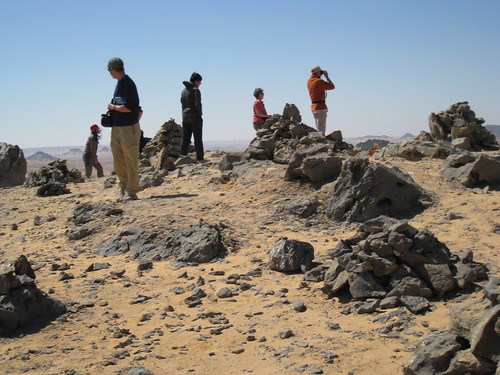A Maltese explorer claims he may have solved one of Egypt’s oldest mysteries. Mark Borda and Egyptian accomplice Mahmoud Marai, an adventure holiday planner, have discovered a large rock in the Western Desert, some 450 miles west of the Nile Valley – inscribed with a king’s cartouche, royal images and hieroglyphs. Ancient Egyptians are thought never to have strayed past Dakhla Oasis, located around 200 miles from the river.
Mr Borda will not disclose the location of his find to protect it from prying eyes. He immediately sent details of the text to compatriot and Egyptologist Aloisia De Trafford, based at University College, London, who passed it onto ancient languages specialist and colleague Joe Clayton. Mr Borda reports that the results have been astonishing, linking by trade the Egyptians to exotic, distant lands. “In the annals of Egyptian history there are references to far off lands that the pharaohs had traded with but none of these have ever been positively located,” he tells the Malta Independent.
“It turns out that the script we found states the name of the region where it was carved,” Mr Borda adds, “which is none other than the fabled land of Yam, one of the most famous and mysterious nations that the Egyptians had traded with in Old Kingdom times; a source of precious tropical woods and ivory. Its location has been debated by Egyptologists for over 150 years but it was never imagined it could be 700 kilometres west of the Nile in the middle of the Sahara desert.”
If true – and it’s far from certain right now (read on…) – Mr Borda’s could be one of Egypt’s biggest recent discoveries. Not only would it push ancient Egyptian culture around 400 miles west of what many believed to be their western limit, but it would also confirm the legendary land of Yam; alluded to in several texts but never found in modern times.
Yet we’ll have to wait for confirmation from the Supreme Council of Antiquities before believing Mr Borda fully: just take a look at the Castiglioni brothers’ Persian Army exploits in the same area earlier this month – discredited by the SCA within days.
However Mr Borda does have previous in the field, having assisted Carlo Bergmann’s 2003 excavations along the Abu Ballas Trail, near Gilf Kebir. That time Bergmann’s team found pottery dating to the 28th Dynasty, and its location became the westernmost border of the Ancient Egyptian Empire – until now, Mr Borda claims: “(Carlo Bergmann’s trip) caused a sensation as it extended the activities of the Pharaonic administrations an unprecedented 80 kilometres further out into the unknown and waterless Western Desert. The find we just made is some 650 kilometres further on! Egyptologists will be dumbstruck by this news.” Will Mr Borda’s claims be confirmed? We’ll keep you posted!
